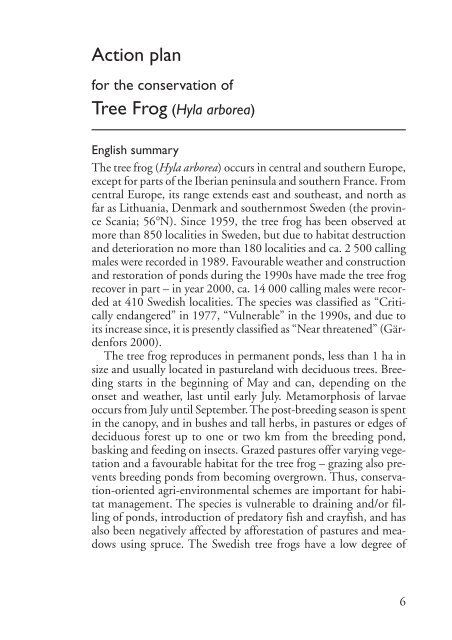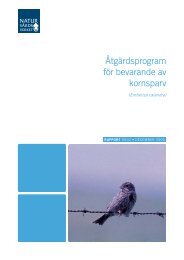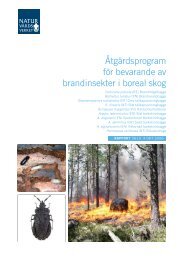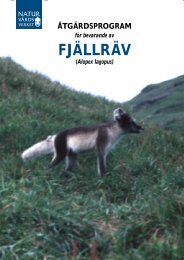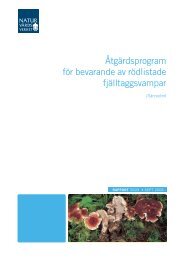Åtgärdsprogram för bevarande av lövgroda - Regional Red List
Åtgärdsprogram för bevarande av lövgroda - Regional Red List
Åtgärdsprogram för bevarande av lövgroda - Regional Red List
Create successful ePaper yourself
Turn your PDF publications into a flip-book with our unique Google optimized e-Paper software.
Action plan<br />
for the conservation of<br />
Tree Frog (Hyla arborea)<br />
English summary<br />
The tree frog (Hyla arborea) occurs in central and southern Europe,<br />
except for parts of the Iberian peninsula and southern France. From<br />
central Europe, its range extends east and southeast, and north as<br />
far as Lithuania, Denmark and southernmost Sweden (the province<br />
Scania; 56°N). Since 1959, the tree frog has been observed at<br />
more than 850 localities in Sweden, but due to habitat destruction<br />
and deterioration no more than 180 localities and ca. 2 500 calling<br />
males were recorded in 1989. F<strong>av</strong>ourable weather and construction<br />
and restoration of ponds during the 1990s h<strong>av</strong>e made the tree frog<br />
recover in part – in year 2000, ca. 14 000 calling males were recorded<br />
at 410 Swedish localities. The species was classified as “Critically<br />
endangered” in 1977, “Vulnerable” in the 1990s, and due to<br />
its increase since, it is presently classified as “Near threatened” (Gärdenfors<br />
2000).<br />
The tree frog reproduces in permanent ponds, less than 1 ha in<br />
size and usually located in pastureland with deciduous trees. Breeding<br />
starts in the beginning of May and can, depending on the<br />
onset and weather, last until early July. Metamorphosis of larvae<br />
occurs from July until September. The post-breeding season is spent<br />
in the canopy, and in bushes and tall herbs, in pastures or edges of<br />
deciduous forest up to one or two km from the breeding pond,<br />
basking and feeding on insects. Grazed pastures offer varying vegetation<br />
and a f<strong>av</strong>ourable habitat for the tree frog – grazing also prevents<br />
breeding ponds from becoming overgrown. Thus, conservation-oriented<br />
agri-environmental schemes are important for habitat<br />
management. The species is vulnerable to draining and/or filling<br />
of ponds, introduction of predatory fish and crayfish, and has<br />
also been negatively affected by afforestation of pastures and meadows<br />
using spruce. The Swedish tree frogs h<strong>av</strong>e a low degree of<br />
6


